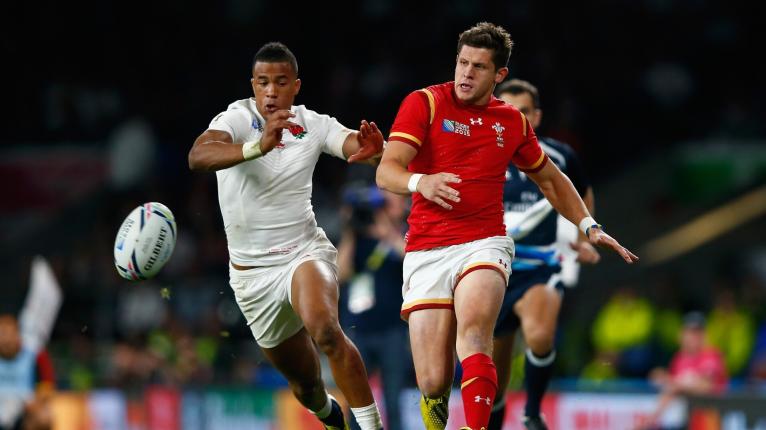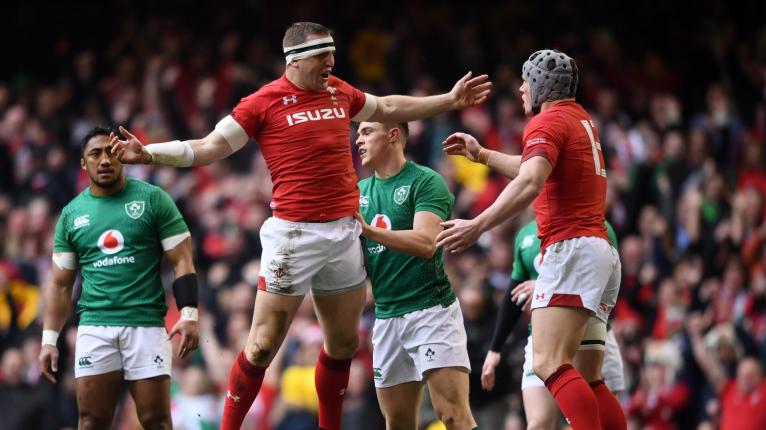The nine sublime moments that stand out most in a decade for Wales to remember

Wales have endured a fruitful decade on the international stage. Two Grand Slams, a further Six Nations title and two World Cup semi-finals were complemented by a No1 world rankings spot earlier in 2019 and two Lions squads rammed with Welsh talent.
All this giddy success means cherry-picking a highlights reel to do it justice wasn’t easy. RugbyPass gives it our best shot…
1. Shane Williams somersaults his way into Welsh hearts (Principality Stadium, 2011)
Warren Gatland recently lamented the one player Wales could not replace. That man was Shane Williams. The wee fella from Amman may have been modest in size but he was a giant in stature for Wales.
Fifty-eight tries in 87 appearances was bettered by only Bryan Habana and David Campese among the tier one nations, but Williams had the best strike rate of the trio. After reaching the 2011 World Cup semi-finals and losing out to France, an end of year Test against the Wallabies was organised and trumpeted as Williams’ farewell.
Wales were soundly beaten on the day but with the last play and the clock in the red, Williams showed his impeccable timing was still intact by skipping outside a flailing Matt Giteau and over the whitewash where he gurned in ecstasy, grounding the ball before harking back to his gymnast years with a somersault.
A visibly emotional Williams set off a feel-good factor that could have powered the national grid.
(Continue reading below…)
RugbyPass talks to England and Leicester centre Manu Tuilagi about all things Lions
2. Dan Lydiate goes felling French oaks (Principality Stadium, 2012)
Wales’ 2012 Grand Slam wasn’t remembered for lashings of verve and flair but for its defensive resolve. Epitomising that steely determination was mid-Wales’ farming poster-boy Dan Lydiate.
For 80 minutes, he rampaged around the field felling Frenchmen below the knees and coined a new phrase, ‘le chop tackle’. Thierry Dusautoir, Clement Poitrenaud, Wesley Fofana, Aurelien Rougerie were all cut down at source with Dusautoir’s felling directly leading to Alex Cuthbert’s vital score down the right flank.
At the end of the game, Lydiate had black eyes forming and a gash across the bridge of his nose – a badge of honour for any blindside.
His performance inspired an Under Armour advert running the woods carrying logs. Little more than a year later, France’s tormentor-in-chief was playing in Paris for a handsome salary with Racing 92.
Who doesn’t like having a back scratch @biglydiate Mav the bull #welshblacks #nativebreed #bull ???????????? @Welsh_Blacks #wearewelshfarming #hillfarm pic.twitter.com/VOGp1EYzXv
— Dan Lydiate (@dan_lydiate) December 29, 2019
3. Wales give England the run-around (Principality Stadium, 2013)
Wales had started the 2013 Six Nations with a traditional loss at home to Ireland but from there, like a boxer off the canvas, they came out swinging. The denouement came with a seismic 30-3 win over England at a pulsating Millennium Stadium.
The cacophony of noise ratcheted up a notch throughout the game. On 65 minutes, with Wales already 20-3, up came the coup de grâce. Taulupe Faletau showed neat footwork to evade Geoff Parling and Dan Cole. From the resulting ruck, Sam Warburton looked up and darted through a gap left by Danny Care, Dylan Hartley and captain Chris Robshaw to hare 50 metres upfield, using a Samoan sidestep to knock Owen Farrell ten yards backwards.
From the resulting ruck, Mike Phillips passed to Dan Biggar who whipped the ball back to Leigh Halfpenny, then Jamie Roberts, who popped the ball to Justin Tipuric who cantered 25 metres, dummying inside Mike Brown and a diving Brad Barritt, to slip the ball outside to Cuthbert to dot down and set off pandemonium.
Twenty-six seconds and eight pairs of hands equalled Welsh nirvana.

4. Gethin Jenkins’ Rorke’s Drift action (Nelspruit, 2014)
This was an unheralded moment but exemplified the bravery exhibited by Wales’ players when under extreme duress. Beddau’s famous footballing centre-back turned his hand to rugby and went on to win 129 caps as a loosehead. Many would say he redefined the position in the same way Tadhg Furlong and Kyle Sinckler have done in recent years in the No3 shirt.
His set-piece work was on point but it was his workrate and breakdown expertise that really set him apart from his contemporaries. In 2014, in the two-Test series in South Africa, Jenkins played his full part in an epic second Test that saw Wales lose agonisingly 31-30 in a game Gatland claimed was the worst coaching disappointment of his career as Liam Williams was penalised for a no arms tackle on Cornal Hendricks to give away a penalty try.
In the first-half, however, Wales were rampant after a couple of tries from Alex Cuthbert and Jamie Roberts. As South Africa looked to hit back, the ball was hoofed into space in the backfield by Willie Le Roux with only Jenkins to cover.
He threw his 18-stone frame over the ball, sat on his haunches with a tackler preventing him from powering back upfield. He waited and waited for Welsh cover as Duane Vermeulen, Willem Alberts and Bismarck du Plessis smashed into him, attempting to clean him out and dislodge the ball to regather and score.
It seemed like an eternity but Jenkins hung on and won the penalty, allowing Wales to clear. At the gateway to Kruger National Park, Jenkins refused to be bullied by the Springboks’ big beasts and it inspired Wales to one of their greatest performances on South African soil.
Life After Rugby: Andy Powell is released on January 1… in the RugbyPass documentary he airs his views on Rob Howley, the now-banned former Welsh assistanthttps://t.co/rT7P9HwOFf
— RugbyPass (@RugbyPass) December 31, 2019
5. Lloyd Williams’ left peg (Twickenham, 2015)
Some people may say Ryan Giggs or Gareth Bale have the most cultured left pegs in Welsh sport but some beg to differ. Step forward Lloyd Williams. The 2015 World Cup pool stages saw Wales facing a heavily fancied England side desperate to assert their physical dominance and for the majority of the game it worked.
Liam Williams left the field on a stretcher concussed, Hallam Amos dislocated a shoulder fending Owen Farrell and Scott Williams departed with a knee injury. This left Wales’ ranks heavily depleted and saw Lloyd Williams, a scrum-half by trade, thrust onto the left-flank.
With Wales trailing 25-18 and with ten minutes to go, a sense of desperation had enveloped the Welsh fans at Twickenham but when Jamie Roberts put Williams away down the tramlines, the ever-astute Cardiff Blues No9 looked up, scanned and with three English defenders blocking his path, dinked the cutest of balls thirty metres infield, seeing Gareth Davies’ scorching tracking line.
The scrum-half picked the bouncing ball off his toes to dot down under the posts and bring the sides level. Dan Biggar sealed the win but it will be Williams’ bright yellow boots that will go down in the annals of Welsh rugby history.

6. Wales’ defensive set brings the house down (Principality Stadium, 2015)
In rugby, it’s traditionally a thrilling score that elicits the loudest of cheers in a stadium but that changed during the 2015 Six Nations when Wales produced one of the greatest rear-guard actions in living memory.
Over seven minutes and six seconds, a well-drilled Ireland side went through 45 phases between the 22 and the Welsh try line yet Wales refused to buckle. The breathless defensive set included tackles by every member of the side and every time an Irish tackler was stopped, the crowd became more defiant.
By the time Wayne Barnes blew up the Welsh crowd were in a state of delirium. Warren Gatland raised his eyes to the heavens and Shaun Edwards no doubt danced a merry-jig. You will be hard-pressed to find a defensive effort that gave more collective satisfaction than the events of that day.
Confirmed. https://t.co/fI1iKBTxoE
— RugbyPass (@RugbyPass) December 26, 2019
7. Liam Williams inspires the Lions of yesteryear (Eden Park, 2017)
Okay, some creative licence is required here. It’s not Wales but the Lions play in red and this most majestic of tries had been heavily influenced by a former scaffolder from Waunarlwydd.
When Anthony Watson gathered the ball from a speculative kick by Aaron Cruden in the first Test, he had two options: take the safe option and hoof it into row Z, or pass it inside to a screaming Liam Williams.
History thankfully tells us Watson chose the latter. Williams, with his devil-may-care attitude, stepped off his right foot to leave Kieran Read clasping thin air, ran laterally to outpace the chasing Cruden and prone Sonny Bill Williams to see the space opening up.
He pinned his ears back and reached the half-way line to pop the ball to his old Scarlets team-mate Jonathan Davies, who shepherded the ball onto Elliot Daly. Daly turned Anton Lienert-Brown inside out and passed inside to the supporting Davies to jink his way to the try-line.
Held up five metres out, he popped it to Sean O’Brien to bullock his way over. Cue bedlam. In the 20th century, you think of ‘Benny’s bounce’ (Phil Bennett) to start the Barbarians’ greatest try against the All Blacks in 1973, and for the 21st century, you have ‘the Sanjay step’. Quite marvellous.

8. Hadleigh Parkes is given wings (Principality Stadium, 2019)
Jacob Stockdale is one of the world’s most dangerous wings. A man who can put the afterburners on and make opposing defenders look like they are treading in treacle but with the roof open, someone must have been smiling down on Hadleigh Parkes, a midfielder not known for his fast-twitch fibres.
When Johnny Sexton hoofed the ball across the field after a penalty in the sixth minute to Stockdale, you would have expected only one winner as the Ulster winger set off at pace.
First, he freed himself from the attentions of Gareth Davies and saw the path to the whitewash momentarily open up. As Stockdale’s 6ft 3in frame ate up the ground in front of him, Hadleigh ‘Bolt’ Parkes kept pace and went airborne to execute a perfect cover tackle with Stockdale only 10 metres short and yanked him into touch before he could recycle.
With his bonce wrapped in some black and white tape, Parkes dusted himself off and looked bemused, as if to say, ‘how the hell did I do that?’ It was a pivotal moment and Wales went on to lift the Grand Slam with a comfortable 25-7 win.
9. Tomos Williams goes into full Dennis the Menace mode (Oita Stadium, 2019)
Picture the scene: After being dumped out of the 2011 World Cup semi-final by France, Wales are set to succumb to the same fate with little over six minutes left as Les Bleus have a put-in on their five-metre line.
Baptiste Serin feeds the ball into his pack with Gael Fickou on the blindside, this after Sebastien Vahaamahina had been sent off, and Tomos Williams, the Treorchy Terrier, circles.
As the ball is fed back to Charles Ollivon at the base of the scrum, Williams outmuscles Serin and manhandles Ollivon, even though he is a full nine inches shorter and four stone lighter. He rips the ball from the No8 and the ball flies 10ft in the air.
As Welsh and French eyes are transfixed, quickest to react is Justin Tipuric, who gathers the ball and dives for the try line. Held up, Alun-Wyn Jones clears out two French defenders, leaving Ross Moriarty to power over the line.
After the TMO adjudges that the ball did not go forward, Dan Biggar slots the conversion to complete Wales’ biggest ever World Cup comeback and leave the French standing behind the posts like they are going to face the guillotine.
WATCH: RugbyPass travelled to Brecon to see how life after rugby is treating Andy Powell








































